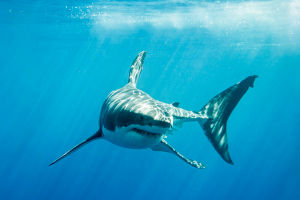In the world of nature, there are numerous incredible creatures—some cute, friendly, or even clever—becoming favorites of both humans and animals alike.
But there is one creature that stands out for its deceptive appearance, which seems harmless at first glance but hides a deadly weapon.
That creature is the electric eel.
Known as the "water tiger", electric eels are often regarded as the bullies of the underwater world. While they are born in saltwater, electric eels tend to pride themselves on being "saltwater fish", looking down on their freshwater counterparts.
Despite this, they actually grow up in freshwater, and the "freshwater fish" bloodline they carry is undeniable. Electric eels belong to migratory fish species, and they are primarily found in the basins of the Amazon and Orinoco Rivers. They are often labeled as one of the most cunning creatures of the Amazon, especially the male electric eel.
The Shockingly Powerful Weapon
What makes the electric eel so terrifying? It's all about its ability to stun or even damage anything that comes too close with its powerful electric charge. While many people find this ability fascinating, it is actually the eel's primary weapon for both defense and hunting.
Electric eels have a highly developed electric system, with over 6,000 electric organs located along their tails. When these organs are activated, they can generate up to 600 volts of electricity, making them the most powerful freshwater fish in terms of electric output.
An adult electric eel can discharge 300 to 800 volts of electricity. This level of power is more than enough to fatally shock a human, which explains the fascination with what many refer to as "this deadly charm".
Interestingly, the electric eel's electric output differs depending on the area of its body. Its head carries a negative charge, while its tail holds a positive one.
If a prey animal touches both the eel's head and tail, or accidentally steps on it, the eel will be triggered and release a powerful shock. This charge can attack large animals like cows and horses—much bigger than itself. In simple terms, the closer you get to the eel, the faster you'll be struck down.
Moreover, the eel's electrical charge only increases as it matures, growing stronger and more potent with age. It's like the old saying, "The older, the more dangerous".
A Morally Ambiguous Creature
If electric eels only used their electric power for self-defense, they might not be as feared. The real danger comes from the fact that electric eels have no moral boundaries and don't follow the "live and let live" principle.
While other animals may avoid harm when they are not provoked, the electric eel isn't bothered by such notions. For it, using electricity is an essential hunting method, and it provides a thrilling rush. When and how it releases its electricity depends entirely on its mood.
Electric eels seem to have an insatiable desire to release electricity. On average, they can discharge electricity 50 times per second, and after a short break, they are ready to shock again. This constant discharging behavior has earned them many nicknames like "generator", "living battery", "electric king", and "the prince of electric music".
Can Electric Eels Shock Themselves?
Some people might wonder, "If electric eels are so notorious for their electric discharges, do they ever end up shocking themselves?" The answer is no. Due to their special body structure, electric eels don't shock themselves in the water. The electricity flows through the water, which has lower resistance than the eel's body, meaning that the eel doesn't feel its own electric charge.
A Force to Be Reckoned With
The electric eel is a creature of contradictions—an underwater enigma cloaked in mystery and power. On the surface, it may appear unassuming, but beneath that slippery exterior lies a force capable of bringing down predators and prey alike. Its deadly electricity, relentless nature, and unpredictable behavior make it one of nature's most fascinating—and feared—creatures.
Whether viewed as a marvel of evolution or a menace of the deep, one thing is certain: the electric eel is a reminder that in the wild, looks can be deceiving, and danger can come from the most unexpected places.


